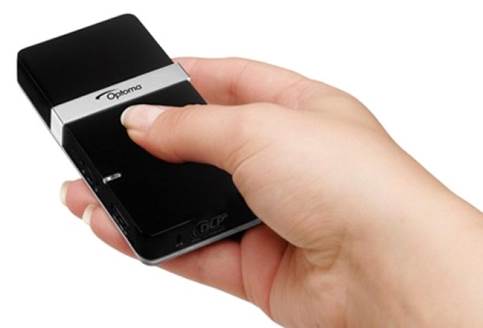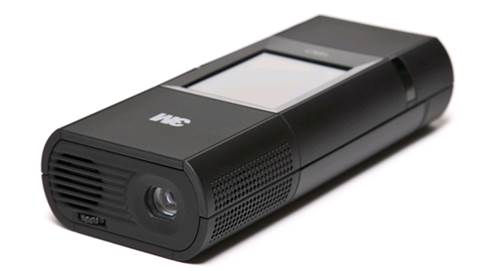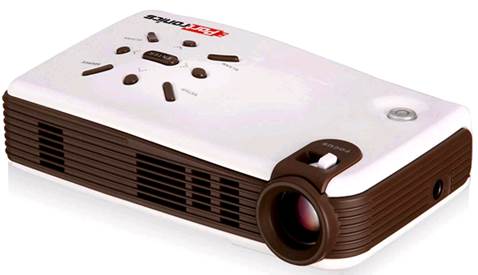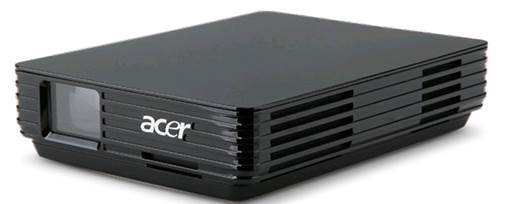Catering to the needs of people on
the go, pico projectors project a large image from a small one. Today, these
projectors have become so small that they are increasingly being embedded in
mobile phones and cameras. Doing away with the need to carry other devices, a
few standalone models also support internal memory.
Entertainment and productivity literally
reside in the pockets of business travelers, movie-buffs or even plain gadget
enthusiasts these days. The fab trimming, belt-tightening trend has certainly
engulfed projectors too, giving rise to a new breed called pico projectors.
When we say 'projectors,' the first thing
that comes to our mind is a large, bulky device used in our offices and
colleges for presentations. The continuous evolution of technology has now
enabled us to get a cinema-like video projection from a compact device.
Welcome to the world of pico projectors!

Pico
projectors for people on the move
Catering to the needs of people on the go,
pico projectors project a large image from a small one. Today, these projectors
have become so small they are increasingly being embedded in mobile phones and
cameras. Doing away with the need to carry other devices, a few models also
have internal memory. These projectors tend to be cheap. If you are one of
those who always carry a laptop or tablet, this tiny device can be of some
great utility.
Before delving further, the key thing to
consider is that these projectors are not very bright. They require a 'completely'
dark room to display images decently. So don't go for these portable pups if
you are hoping for a vivid image that comes out of a full-fledged large
projector.
Choose the devices you wish to connect
Just like media players, these projectors
can comfortably pull video signals from a variety of devices like DVD players,
laptops, mobile phones and cameras. If you have the latest models of these
devices, you need not worry about their compatibility with your pico projector.
The more inputs the projector has, the better. It would be wise to check which
devices you are likely to pair before choosing a projector. Among the most
common inputs are VGA (laptop), A/V (RCA) and Composite. Addressing the demands
of new-age consumers, a few projectors even support HDMI, Wi-Fi and iPod/ iPad
connectors.
Pico projectors are USB-friendly
Aping smartphones, some projectors support
USB connection only, which provides dual compatibility for both data and power.
Usually, such models have no internal battery. These are often called the 'USB
projectors.' These serve just like pico projectors, connectivity being the
only difference.
Technologies used
Pico projectors have LEDs as light source,
which implies these projectors have a long useful life due to efficient use of
battery power. In most models, display technology is either DLP or LCoS.
Overall, there are four distinct
technologies powering these portable projectors:
LCoS (liquid crystal on silicon)
It uses a small LCD panel to filter light
from an LED source. Together with DLP, this is the most popular technology
these days.
DLP (digital light processing)
It comprises tiny mirrors on a chip to
direct light from an LED source. It is used by many companies including Optoma,
LG and Samsung.
Laser-LCoS
It is the same as LCoS filter, with laser
light source being the only difference.
Laser-beam-steering
Being the latest one, there are only a few
products available with this technology. It uses lasers and a single tiny
mirror (some models use two) to direct the light. The image is created one
'pixel' at a time. Lasers are bright, efficient and always in focus, but suffer
from Speckle effect. A speckle is a sort of interference produced by
random-intensity patterns occurring out of a set of wave fronts. In a general
sense, it implies to shiny metallic dots visible all over the image.
Cabling requirements
Pico projectors come with the convenience
of reduced space requirements. It is not that tough to find a good place for
them to project where you want to. But when you add those entangled cables from
another gadget, these projectors might give you a headache. Some projectors
support internal memory and/or memory cards, so they can play content without
the need for another device. Some can play videos and images, while others also
support office documents.
Battery life
Majority of these projectors can run for
about an hour on their rechargeable battery. This run time limit can actually
play spoilsport in watching full-length movies. So look out for models that offer
external batteries. You can buy these batteries along with the projector.
Weight
Pico projectors usually weigh 150 to 250
grams. Moving up the price ladder, some projectors are really light at around
85 grams, but these do not include a battery and must be powered using a USB cable.
Some popular models in the market
3M MP180
Price: $550

3M
MP180
Features:
·
Resolution: 800x600
·
Type: LCoS
·
SD card support: Yes
BenQ Joybee GP2
Price: $720

BenQ
Joybee GP2
Features:
·
Resolution: Up to 1200x800
·
Type: LCoS
·
SD card support: Yes
Portronics POR315
Price: $423

Portronics
POR315
Features:
·
Resolution: 1024x600
·
Type: LCoS
·
SD card support: Yes
Acer C110
Price: $295

Acer
C110
Features:
·
Resolution: Up to 1280x800
·
Type: LCoS
·
SD card support: No (Only USB)